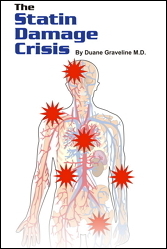Are Statins Changing the Dynamics of Death?
 Years ago this 94-year old, healthy appearing male came into my office and told me that he felt he was coming down with a slight “cold” and would I admit him to our local hospital “just in case”.
Years ago this 94-year old, healthy appearing male came into my office and told me that he felt he was coming down with a slight “cold” and would I admit him to our local hospital “just in case”.
I took an appropriate history, looked him over, pronounced him sound and said, “No. I would not do it because it was inappropriate hospital utilization.” The gentleman smiled and left my office without further discussion, apparently satisfied.
Two days later during my hospital rounds there he was in a hospital bed reading the paper. He gave me a wave and big smile as I walked past his room.
Often I have thought of this case where I was both obviously right and just as obviously wrong in my management of him. I had made a judgment that I do not admit common, uncomplicated colds regardless of age. He made the judgment that I was wrong and knew that getting admitted to the hospital was just as easy as calling the right doctor.
I am older now, wiser, perhaps, and probably more compassionate but death remains inevitable and my job as doctor is to prevent premature death, isn’t it? But there you have the “catch”. Who defines premature?
Through enhanced imaging studies and sophisticated surgical technology we have drastically reduced acute mortality from heart attacks and strokes. No doubt, people who as patients would have died 25 years ago now are living longer to die of other causes, most notably of cancer.
Statin drugs have contributed to this changing picture of morbidity and mortality. Atherosclerosis has an inflammatory basis many researchers now inform us. The role of cholesterol and cholesterol manipulation by statins drugs is now considered to be irrelevant.
Statins’ actions include their powerful anti-inflammatory effect, that of nuclear factor kappa B (NF-kB) inhibition. Through this action, platelet activation and inflammatory cellular responses are modulated.
Through this combination of factors we are slowing down premature death from cardiovascular disease but speeding up all-cause mortality, for death cannot be cheated and cancer deaths are the major contributor in our later years.
Two factors are contributing to the emergence of this new pattern of death. One of these has to do with effect of statins on those mechanisms contributing to the process of atherosclerosis thereby lowering cardiovascular death risk.
All statins have been proven to have an effect on monocyte function allowing monocyte migration and adhesion on the activated endothelial cell surface, a vital element of the inflammatory reaction.
A second major role of statins has to do with enhancing the bioavailability of the powerful vaso-dilator, nitric oxide, by interfering with endothelial nitric oxide synthase. Another function of all statins is to enhance macrophage activity vital to all phases of atherosclerosis from initiation and progression through plaque rupture and thrombosis.
The fourth major effect of all statins has to do with proliferation and migration of smooth muscle cells vital to the full range of atherosclerotic expression.
The other contributory factor to the emergence of new patterns of death is the ever aging population combined with the effect of statins on immuno-resistance via inhibition of NF-kB.
We have had three billion years to evolve our defenses against viruses, bacteria and cancerous cells in this war of multi-cellular organisms against our uni-cellular foes and NF-kB is critical to all of them. A predictable consequence of this is cancers of all kinds and we are seeing increasing incidence of cancers.
From the viewpoint of a doctor knowing that almost all of his patients by age 95 will be taken by one process or another, changing specific disease death rates is an exercise in futility, unless these deaths are premature.
Once you overcome the pre-maturity factor what good are you doing? You really have to think about this. It is almost like asking, “How would you prefer to die? Heart attack,stroke or cancer?” The inevitable consequence of mass utilization of statins is cancer – the big one. With the increased time to die and tremendous increase in costs of cancer care are we really making progress with statins?
And as we step back and take a dispassionate look at what we have accomplished, we have lowered coronary heart disease deaths but it has been due primarily through rapid progress in technology. The statin contribution, comparatively, has been very little — a relatively few high risk males.
The true costs of statins are known only to the drug companies and the national medical governing bodies. Prescribing physicians have been almost completely shielded from the truth. If they knew what statins really did to our brains, muscles and nerves they would be shocked.
Duane Graveline MD MPH
Former USAF Flight Surgeon
Former NASA Astronaut
Retired Family Doctor
November 2015






